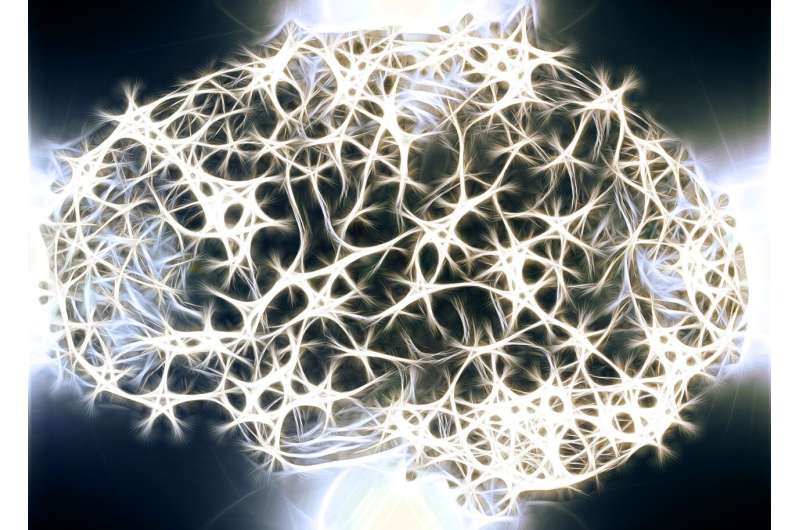This article has been reviewed according to Science X's editorial process and policies. Editors have highlighted the following attributes while ensuring the content's credibility:
fact-checked
peer-reviewed publication
trusted source
proofread
'MUSIC map' reveals some brain cells age faster and are more prevalent in Alzheimer's

Engineers at the University of California San Diego have discovered that some brain cells age more rapidly than others, and they are disproportionately abundant in individuals afflicted with Alzheimer's disease. Additionally, researchers observed sex-specific differences in the aging process of certain brain cells, with the female cortex exhibiting a higher ratio of "old" oligodendrocytes to "old" neurons compared to the male cortex.
The discoveries were made possible by a new technique called MUSIC (multinucleic acid interaction mapping in single cells), which allows researchers to peek inside individual brain cells and map out interactions between chromatin—which is the tightly coiled form of DNA—and RNA. This technique enables researchers to visualize these interactions at single-cell resolution, as well as study how they influence gene expression.
The work is detailed in a paper published in Nature.
"MUSIC is a powerful tool that can allow us to dig deeper into the complexities of Alzheimer's disease," said study senior author Sheng Zhong, a professor in the Shu Chien-Gene Lay Department of Bioengineering at the UC San Diego Jacobs School of Engineering.
"The technology has the potential to help us uncover novel molecular mechanisms underlying Alzheimer's pathology, which could pave the way for more targeted therapeutic interventions and improved patient outcomes."
The human brain houses a complex network of cells that communicate and interact in intricate ways. Within each of these cells lies a dynamic interplay of genetic components, including chromatin and RNA, which dictate crucial cellular functions. As brain cells grow and age, these interactions between chromatin and RNA change. And within each cell, these complexes can vary widely, especially in mature cells. However, unraveling the nuances of these interactions has remained a formidable challenge.
Enter MUSIC, a cutting-edge tool that offers a window into the inner workings of individual brain cells. Using MUSIC, Zhong's team analyzed postmortem brain samples, specifically human frontal cortex tissues, obtained from 14 donors aged 59 years and older, some with Alzheimer's disease and some without.
They found that different types of brain cells exhibited distinct patterns of interactions between chromatin and RNA. Interestingly, cells with fewer short-range chromatin interactions tended to display signs of aging and Alzheimer's disease.
"With this transformative single-cell technology, we discovered that some brain cells are 'older' than others," said Zhong. Notably, individuals with Alzheimer's disease had a higher proportion of these older brain cells compared to healthy individuals, he explained.
Researchers say the discovery could aid in the development of new treatments for Alzheimer's disease.
"If we could identify the dysregulated genes in these aged cells and understand their functions in the local chromatin structure, we could also identify new potential therapeutic targets," said study co-first author Xingzhao Wen, a bioinformatics Ph.D. candidate in Zhong's lab.
The study also uncovered sex-specific differences in the aging of brain cells. In the cortex of female mice, researchers found a higher ratio of aged oligodendrocytes to aged neurons. Oligodendrocytes are a type of brain cell that provide a protective layer around neurons. Given their critical role in maintaining normal brain function, an increased prevalence of aged oligodendrocytes could potentially exacerbate cognitive decline.
"The disproportionate presence of old oligodendrocytes in the female cortex could shed new light on the increased risks of neurodegenerative and mental disorders observed in women," said Wen.
Next, the researchers will work on further optimizing MUSIC so that they can use it to identify factors—such as regulatory genes and gene circuits—that are responsible for the accelerated aging observed in specific brain cells.
"Subsequently, we will devise strategies to impede the activity of these genes or circuits, in the hopes of mitigating brain aging," said Zhong.
More information: Xingzhao Wen et al, Single-cell multiplex chromatin and RNA interactions in ageing human brain, Nature (2024). DOI: 10.1038/s41586-024-07239-w



















